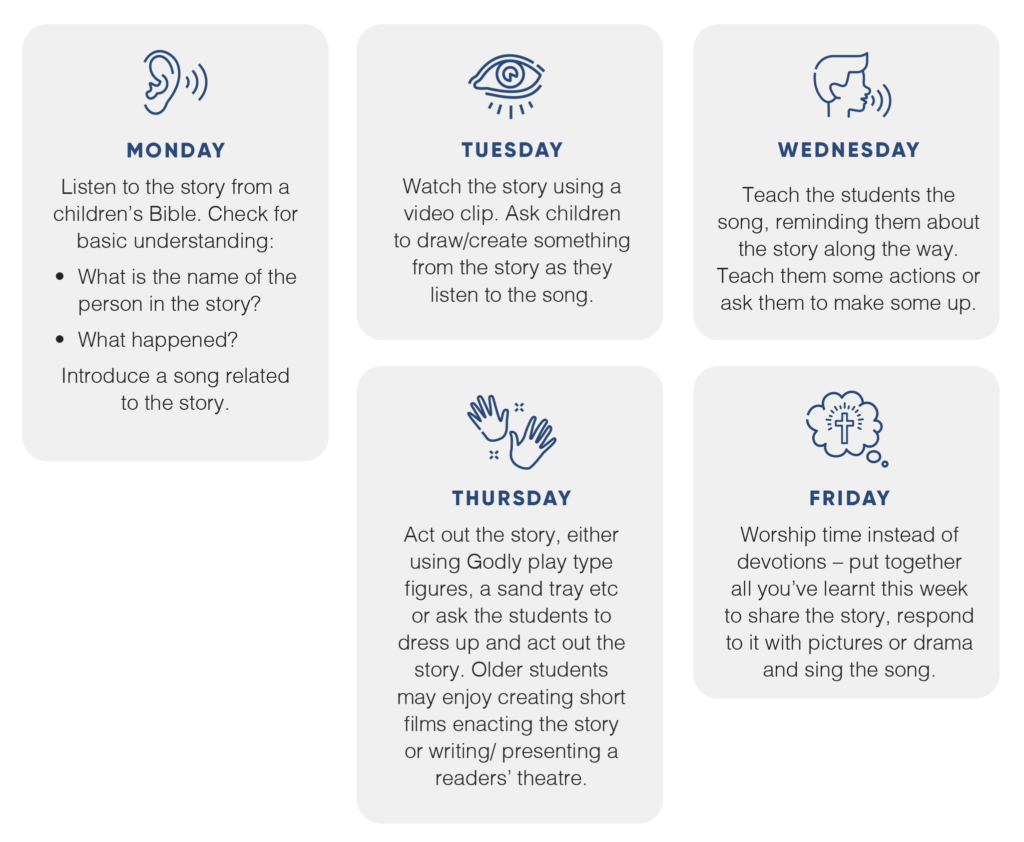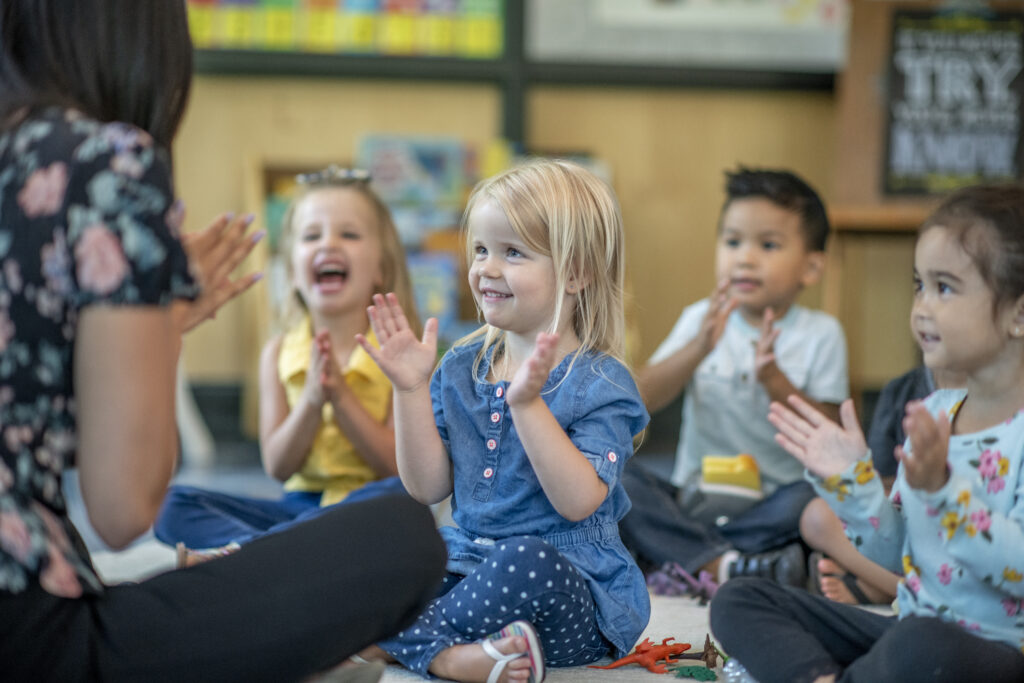While the core elements remain the same in devotions (invocation, Bible reading, prayer and blessing), the style of devotions and the ways students engage with the text can be varied. Giving students an opportunity to explore the Bible in a variety of ways can help them understand and internalise the text.

Exploring and Engaging
We learn with all our senses, and we each have our different ways of processing new ideas.
Our God is a Creator God, and he made us in his image. The ideas below are intended to help students and staff engage with the Bible by providing multiple ways to encounter and respond to what God is doing through his Word.
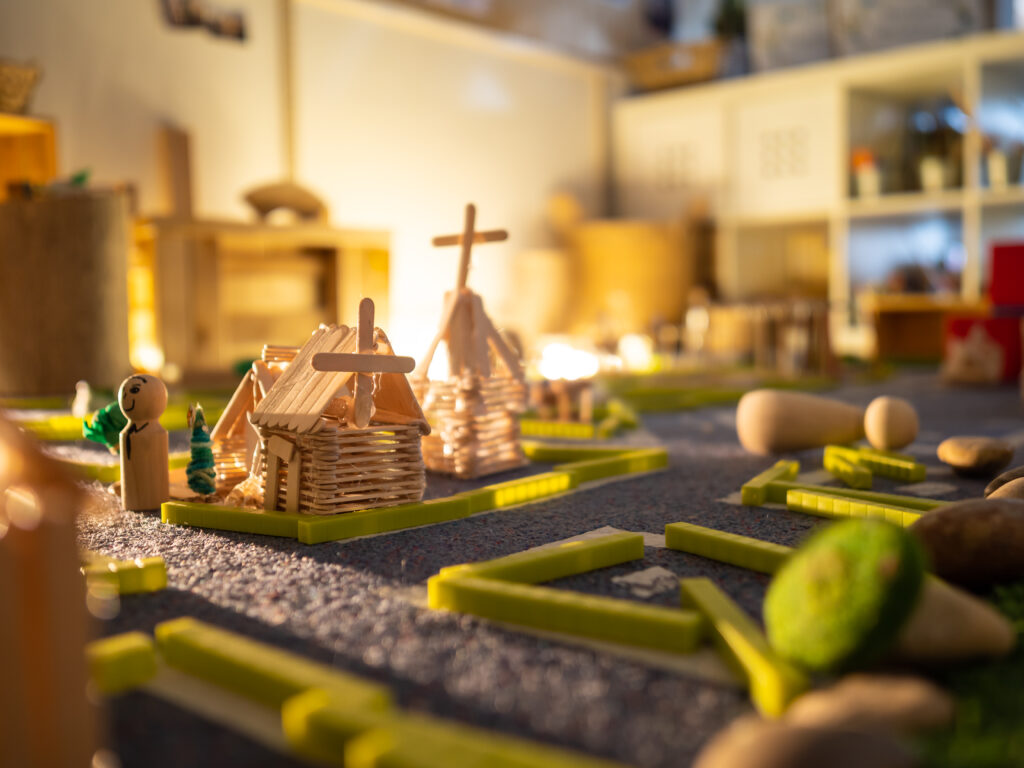
Prepare, Engage and Reflect
In her book, Transformational Children’s Ministry, Ivy Beckwith talks about the importance of giving children and young people the opportunity to explore Bible texts. She talks about the ‘Prepare, Engage, Reflect’ model, which begins with a brief introduction or engaging thought/question and then goes straight to hearing/reading the Bible story of passage. Students then have the freedom to explore and engage with the text in multiple ways, perhaps choosing how they want to experience the passage.
Once they have had a chance to engage with the text, students are ready to reflect, making connections and letting the Holy Spirit work within them to apply what they’ve heard.
This is a different approach to some traditional devotionals, which go straight to ‘this is what this means and this is what you should do’. While the Bible Story Resources include some of this so teachers know how a story can be understood, there are multiple resources given which can help students of all ages explore the stories and actively engage with the Word of God.
Setting up a Pattern
The age-band Guides to Devotions include some patterns which you may like to use or adapt for your context. These are predicated on taking a ‘slow down and explore’ approach to Bible texts. Rather than having a new passage each day, you may want to choose one passage or story per week and enter into it in multiple ways.

Creative Response Ideas
There are a lot of ways students can respond creatively to a Bible story or text.
- ask students to draw their response to the text, perhaps while listening to some music connected to the text.
- create a collaborative artwork
- provide making materials (glue, tape, cardboard and different papers, old magazines, string etc) OR building blocks (eg Lego), and challenge students to build something from the story.
- ask small groups to create a table top/altar display illustrating the key parts or message of the story
- doodle while listening to the story or create a doodled or illustrated version of the memory verse or key words from the story.
- give students the opportunity to do some creative journalling, where they combine collage/drawing/painting with key verses from the text and their own thoughts and reflections. This is especially good for teenagers, if time permits. Keep a storage box with coloured papers, glue sticks, old magazines, coloured pens etc ready to pull out, and make sure each student has their own journalling book (basic exercise book is fine).
- do a craft activity related to the story (eg making an ark for Noah’s ark)
- give students playdough or plasticine and ask them to make key figures from the story. Older students could create a representation of how a character might have felt or what they are taking away from the story.
- explore symbols related to the core message of the story/passage – look at traditional symbols and how they are used, and create your own/make decorations for the classroom using the symbols.
Examples/Resources
GROW Ministries – Equipping for intergenerational ministry – Freed to download kit, especially ‘Leading a creative response.’
Blessing wall While this example was created for use in school worship, it could be adapted for use in a classroom.
Drama Ideas
Acting out a story can be a powerful way to engage with the text.
Even very young students will enjoy dressing up and acting out a story, and they are likely to recall more of the content when they actively participate. Adding props and costumes is fun but not essential.
Drama activities can include:
- simple miming of the events in a story while a narrator reads the story aloud.
- using puppets or toys to act out the events.
- dramatising the reading, by having multiple people read – one or more for the narrator, one for each character with direct speech in the text.
- reader’s theatres – dramatised versions of the story.
- skits – small dramas, often humorous, based on but not necessarily directly from the Bible story.
Resources
The Skit Guys Reader’s Theatre Skits – pay-to-download

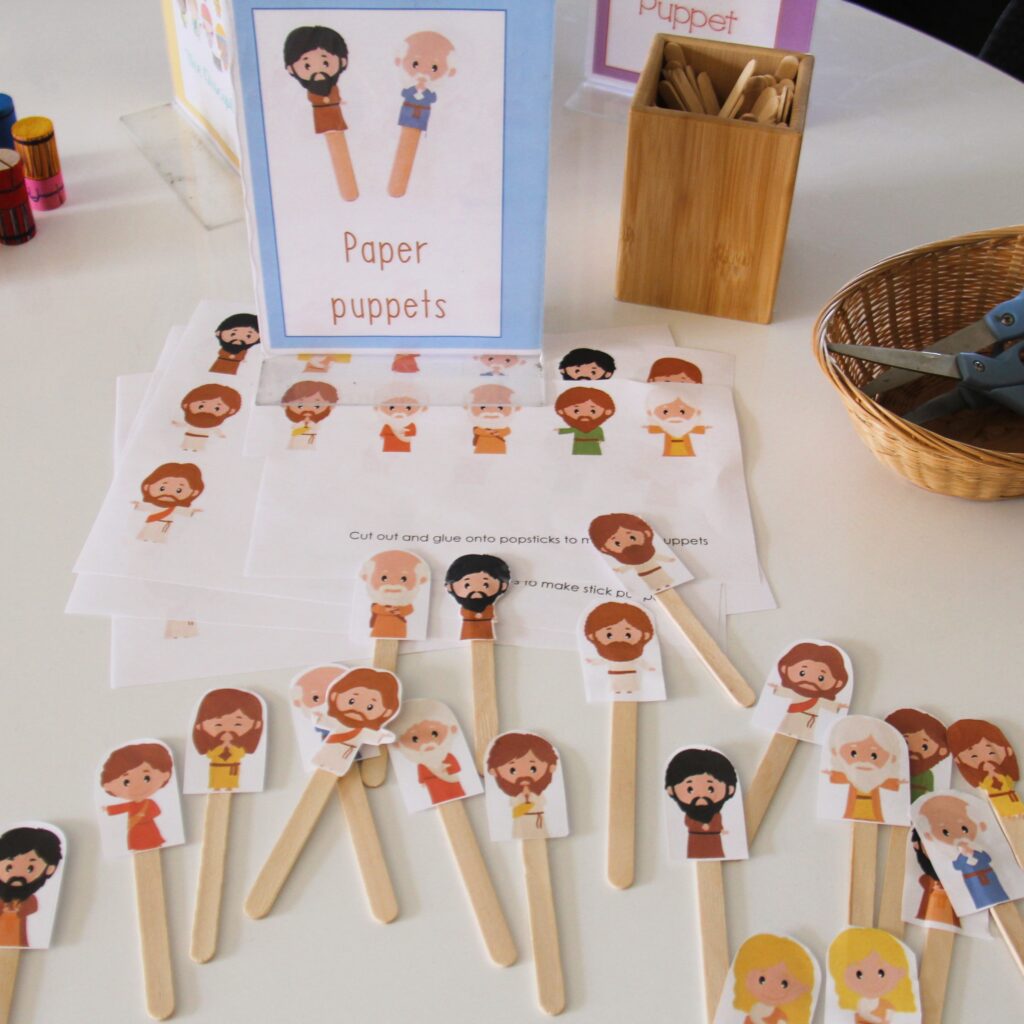
Activities and Interactive Play
Depending on the Bible story or passage, there are lots of activities which can help students engage with the text.
These could include:
- crosswords, find-a-words, colouring pages and other printable activity sheets.
- activity stations which have puppets, toys, wooden figures etc which children can use to respond to the story. This could include helping students to answer wondering questions like, “How do you think Mary felt when the angel told her she was going to have a baby?”
Games
Games are a fun way to engage students in devotions. They don’t have to take a long time or be elaborate.
Some game ideas include:
- Holy Headbands. Grab some post-it notes and write the names of different bible characters on each one. Without seeing the name, have each person stick one on his or her forehead. Then, the players go around asking only yes or no questions to the other players until they can guess who they are.
- Bible Charades. This version is similar to the regular charades, except that they guess bible characters or stories. Split your group into equal teams, then each team writes down bible characters for the other team to act out and guess. Teams get points for the number of characters that they guess correctly.
- Picture This. As you read the chapter, story, or lesson, have one student be your scribe. Hang up giant sticky note paper or butchers’ paper and take turns drawing what is going on in the passage. Kids have to pay close attention because they never know when they will be handed the pen and will need to take over in creating the picture.
- Simon Says or Follow the Leader for stories about obedience, Blindman’s Bluff for stories about trust, etc.

Music Ideas
Music is a great way to reinforce the message of a Bible story. It also creates a mood, and encourages students to be involved.
Here are some ways to use music in devotions:
- sing! teach students to praise God through singing. This could be traditional children’s songs, hymns or contemporary music.
- play instruments – if you have musical students, or you can play an instrument, use this in your devotion time. Hand out shakers, bells etc so all students can make a joyful noise.
- Some older students may have gifts in writing music. Consider including this as an option during creative response sessions. If you are focusing on a theme across multiple weeks, this could give the students time to work on a piece to share at worship.
- dancing and action songs – put on a great song and have a dance party. You can choose a song with actions or encourage students to make up their own.
- use music for reflection time. Put on a quiet song or instrumental music for students to listen to while they spend time in silent prayer, drawing or journalling.
Christian Meditation and Reflection
All students will benefit from the opportunity to be still and silent. These are skills that will need to be taught. You will need to establish class guidelines for these times and start with small amounts of time, eg 2 mins and gradually build up the time. In these times you can conduct guided meditations or personal reflection and prayer time. You will need to suggest words or prayers that can be used in these times.
Christian meditation and reflection can take a number of forms.
- Guided meditations use a narrator to calmly and quietly read a script, while participants close their eyes, lie down or sit quietly. In the Christian context, the script focuses on a passage from the Bible, prayers or a short devotion bringing out the theme of the Bible text.
Here is an example:
Guided Meditation – The Garden – Chaplain Kirstin’s Blog (wordpress.com)
- Silent prayer – after a group prayer, allow a short time of silent prayer where students can add their own concerns to God. Always let students know in advance that is what you will be doing.
- Reflection is response to a piece of music or an image. Play a piece of quiet music with great lyrics, or provide a selection of images to choose from. Ask students to sit quietly, listening to what God might be telling them through the music or image. If using images, it might be wise to play quiet instrumental music so the silence isn’t uncomfortable.
Resources and Examples
Bits of Positivity – list of Christian meditation videos for kids
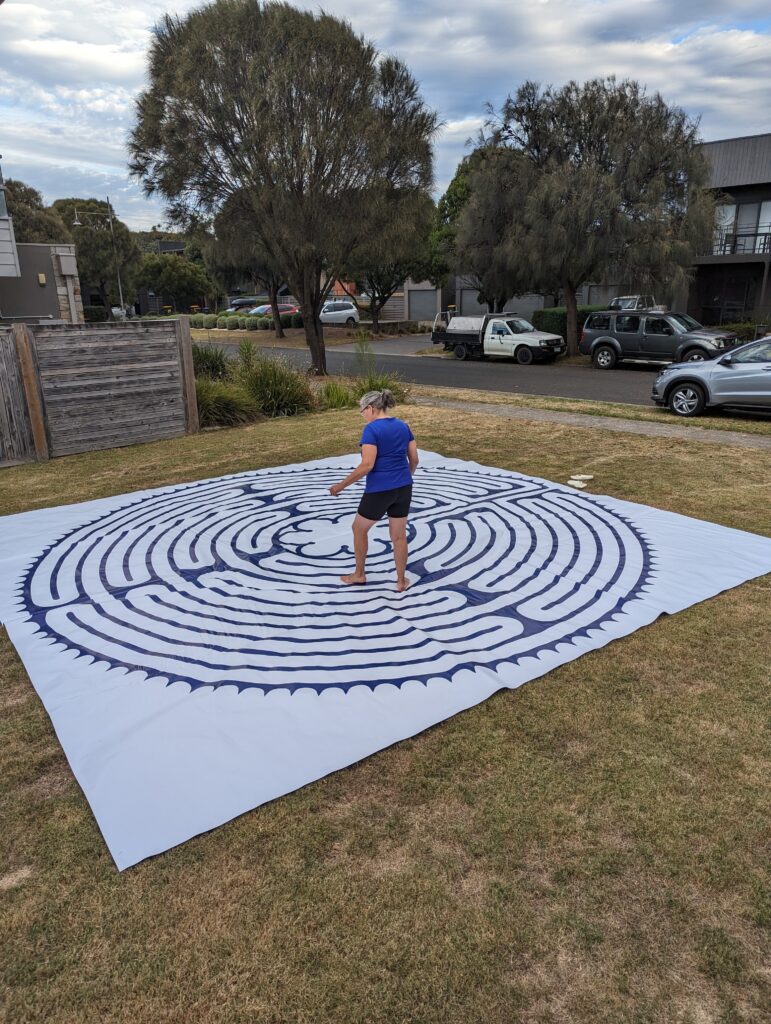
Labyrinths
In 325 A.D. Christians placed a labyrinth on the floor of their church. Although Christians must have been using the labyrinth earlier, this is the first historical record we have of the Christian use of the labyrinth. Since that time labyrinths have been prayed, studied, danced, traced and drawn as Christians sought to use this spiritual tool for prayer.
Using a labyrinth involves moving one’s body and opening one’s heart to Jesus. All you have to do is follow the path and you will find the centre.
Unlike a maze, the labyrinth has no tricks. A “typical” labyrinth experience involves preparing oneself at the threshold, following the single path to the centre, spending time in the centre, following the same pathway out the threshold, and then responding to the experience.
Labyrinths can be very large, permanent structures, temporary constructions (for example, drawn in chalk on the basketball court), or small and personal, hand-drawn or traced in a sand tray.
Resources
Labyrinth Resources from LEVNT -contact the LEVNT Director of Formation to borrow the large moveable labyrinth mat.
Outdoor Devotion Ideas
Walk and pray
Moving your body while you pray or talk can be very helpful.
Students could:
- break into small groups or pairs and walk in a quiet part of the school, sharing each other’s highs and lows or praying for each other and the world as they walk.
- go for a walk in nature, noticing all the amazing things God has made. At the end of the walk, pray together, thanking God for his goodness.
- create a pray and walk stations – at different points around the grounds set up prayer/activity stations with a different intention at every stop. For example, start in school chapel or church – pray for hope for the world; near the school motto on a wall – pray for love in our hearts; at a quiet place in the school grounds – pray for peace; in a corner of the library – pray for the gift of wisdom; and in the playground – pray for forgiveness in our world and in our own hearts.
Other outdoor ideas
- Combine creativity and the outdoors and send students out to draw something God created or draw their response to the Bible story.
- Engage in some nature play – work together to build something connected to the Bible story or play with water, sand or found objects to act out the story.
- Hold your regular devotions outside in nice weather – it’s amazing what a change of location can do!


